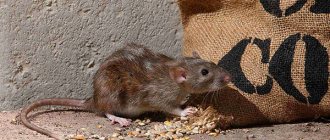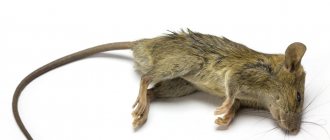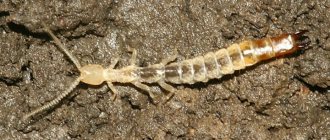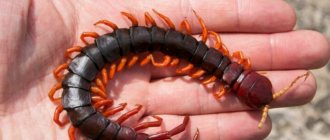The domestic white and clean rat is a tame animal that is distinguished by its sharp mind and quick wit. The pet lives warm and in complete contentment, but if you leave the rat unattended, it will immediately play a cute prank, running away to a place inaccessible to people. Now imagine the same intelligence, ingenuity, survival in any conditions and constant hunger - this will be the “portrait” of a wild rodent.
Rats in the house are a disaster of enormous proportions. Prevention of the appearance of pests is carried out constantly, and if signs of an “enemy” are detected, war is declared on him. And you shouldn’t think that one-time measures will save you from invasion. If rats smell easy prey, they won't leave so easily. Prey is considered to be everything that can be eaten and chewed - from food to cables and insulating material.
Don't underestimate the intelligence of rats. They are social animals with incredible fertility. The rodent will bypass cunningly placed traps, and if an individual is caught, the second one will immediately understand the threat and transmit a danger signal to other animals. Let us remember that rats are pack animals, so when one individual appears, others will not keep you waiting. A smart enemy requires special protective measures, so we will consider all the ways to get rid of rats indoors.
What is the danger of rats in the house?
The first is an unpleasant appearance. In nature, some individuals reach a length of up to 40 cm, but this is with a tail. Seeing this in an apartment or house is an unpleasant sight. But this is not the worst thing:
- Rats carry diseases that are extremely dangerous to humans. These are tuberculosis, rabies, cholera, jaundice, etc.
- Rodents, without a twinge of conscience, will eat all the supplies in the closet; they will not disdain pet food, wiring, insulation, decoration and furniture.
- Rats in the house leave feces, urine, where there are a lot of worm eggs, parasites. Pests carry fleas and ticks on wool.
Cases of rodent attacks on humans have long been known. When squeezed into a corner, the rat will defend itself. She can jump, scratch, bite. An infection from the mouth or claws will get into the wound and the matter can end very sadly. It's even worse when rats appear in a house with small children. The smell of babies is incredibly attractive to rodents, so it is worth keeping in mind and applying methods on how to get rid of rats in the house.
How do rats get into a house and apartment?
As for a private building, everything is clear here - rats in the house appear from the street, from the underground, settle in the attic and in boiler rooms. But city residents are not spared from visits from unpleasant guests. Rodents enter the apartment from various places:
- along air duct shafts;
- from the garbage chute;
- from the basement;
- through sewer mines.
There have been cases when pests entered an apartment through a 2 cm gap, climbed the walls up to the 3rd floor and even settled in elevator shafts. If there are neighbors' garbage bags on the site, this is the best “yummy” for rodents. In a couple of days, a “family” of pests will settle in the entrance, and it will be extremely difficult to get rid of them.
Professional rat repellents
The use of poisons is much more effective, and they are produced in the form of granules, liquid solution or powder. Poison bait can be mixed into food or simply placed pellets in areas where rats are most likely to be found.
Such poisons can be either immediate or long-acting. It is important to understand that a fast-acting poison is only suitable for a small population of pests, but will get rid of them in one day. The use of drugs with a prolonged effect is excellent for combating large concentrations of rats, but you will have to spend much more time.
The most effective long-acting remedies are:
- Ratindane;
- Krysid;
- Ratman;
- Rakusid;
- Zookoumarin.
Among the instant-acting drugs, it is worth noting Krysin, which kills pests within one day.
Poisons effectively kill rodents, but have a number of disadvantages:
- Poisonous bait can be eaten by a pet or child.
- A poisoned rat may go into the house to die. As a result, you will be left with a rotting, smelly corpse in the walls or under the floor. It will be necessary to find and destroy it to get rid of the unpleasant odor.
- Rats adapt to poisons. If a rat survives after eating a poisonous bait, then its offspring will no longer be susceptible to this type of poison.
Signs of rats in the house
Spotting smart animals is difficult, but not impossible. If rats appear in the house, they will:
- feces;
- ammonia smell;
- corpses of rats and mice;
- chewed food bags.
One female can reproduce up to 12 times a year. Each litter consists of 8 to 12 individuals. In a year, only one individual will bring more than fifty new “fighters”, and given that there are about 20 animals in the flock, the size of the “army” becomes threatening.
If you see any traces of a rat in the house, be sure to take action. Trace the path to the nest to clearly understand the location of the enemy. If you catch an animal by surprise, you should not rush at it with your bare hands, as this risks bites, bites and serious scratches.
What do rats eat?
Although rats are classified as omnivores, most of their diet consists of protein foods. They hunt small rodents, insects, frogs, lizards and often destroy bird nests. Rodents living on the shore can catch small fish and shellfish . Rats living near people feed on leftover human food and pet food.
Domestic rodents require a balanced diet, which includes special food and protein foods in the form of nuts, cheese and boiled meat. In addition, the rat should always have access to clean water, and rodents should be given a vitamin complex every six months.
IMPORTANT! You should not feed your rat leftover human food, as this can lead to digestive problems for your pet.
Preventing the appearance of rats in the house
It will not be possible to completely protect yourself from the penetration of pests from the outside, but a number of measures will help avoid the threat:
- The cracks are sealed with putty. Ventilation outlets are covered with fine mesh. The cell size should be no more than 15 mm; after 20 mm, the offspring will already pass through, which will quickly grow and breed.
- Window openings are covered with mosquito nets. It will become a warning barrier. And if the mesh is torn, they look for rodents and take measures to get rid of rats in the house.
- The gaps between the doors are closed with seals, and the holes for cables are closed with plugs. Hatches are equipped with latches, and drainage channels outside the house are covered with nets.
As preventative measures, timely emptying of the trash can and thorough cleaning of surfaces from food debris helps. It is better to double-check the bags of cereals and seal them tightly. And, of course, you shouldn’t flush leftover food down the toilet; this smell will literally “lure” rodents into your house and apartment.
What to do if rats are found?
You shouldn’t immediately panic, because getting rid of rats, although difficult, is quite possible. Make an action plan and buy all the necessary supplies:
- Check the entire house and the area around it for rat holes. If you find their lair, it will be much easier and faster to get rid of the rodents. After using deratization agents, all holes in the house must be sealed with cement, plaster, filled with polyurethane foam, etc.
- Hide all the food. If you store grains in large quantities, then put them in thick plastic bags or boxes, which are treated on the outside with a rodent repellent.
- Choose means of deratization. The more options you use, the faster you will get rid of rats.
There are several ways to kill rats:
- use of rat traps;
- professional chemicals, poisons;
- electronic repellers;
- folk remedies.
Ways to eliminate rats in the house
Let’s say right away that the options of catching and releasing pests do not have any effect. When choosing ways to get rid of rats in the house, owners use the most effective means. Let's look at some of them.
Traps
The effectiveness of traps is no more than 30%. Regardless of the type or type of device, smart animals will soon learn to recognize danger and will not go where they will die. The only exceptions are “outsiders”; the traps can handle them quite well.
Ready-made devices of mechanical and electronic types are offered for sale. Before getting rid of rats using a homemade device, they calculate the size of the structure - the rat trap should be much stronger and larger than the mousetrap. The animal can easily gnaw through steel wire and deal with plastic and wood.
Traps are inspected and emptied once a day. Handling pests with bare hands is strictly prohibited. Carcasses are disposed of by fire or thrown into a trash bin.
Poisoned baits
Manufacturers offer a wide range of baits with toxic substances. The effects vary, some cause paralysis, others cause internal bleeding. Home craftsmen themselves prepare mixtures from grain, broken glass, lime and alabaster. After such a “treat” the rat will want to drink, the alabaster will harden, and the pest will die.
Baits are placed in the same way as traps - on the paths to the nest or where the pests have left traces of their vital activity.
It is strictly forbidden to use rat poisons in the house. The poison is dangerous for people and pets. Treatment with chemicals is carried out only by pest control specialists. They will set traps with poison, so it’s easier to shift the problem of how to get rid of rats to them.
A poisoned individual can crawl quite far, so the method is effective, but with some disadvantages. It’s difficult to find a carcass, but you have to look for it, otherwise it will start to emit a terrible smell.
Glue traps
This method of how to get rid of rats in the house is suitable as a preventative measure or for small concentrations of rats. Special glue is applied to a durable base and placed in path areas or near rodent nests. Once the pest steps on the glue, it will no longer be able to leave the trap. Disposing of the individual and laying out new traps is the responsibility of the owner.
Fight for life
At home, they use modern glue-based traps, poisonous bait, and prepare their own poison for rats.
Traps
Fighting rats with glue traps is very popular. Especially if the apartment is uninhabited. The product is made in the form of glue and is sold in a tube. Does not dry out for 2 weeks, firmly fixes the animal’s paws at the first touch.
- The glue is applied to plywood, oilcloth, or a piece of plastic and firmly fixed to the floor. To catch rats, you need a piece with an area of 50*50 cm.
- Distribute the glue in a continuous line at a distance of 5 cm.
- The bait is placed in the center. The rat hears the smell of food, makes its way to it, and sticks its paws to the rodent glue. The more he tries to get out of the trap, the more he ends up in it.
The advantage of a trap is that several individuals can be caught at once. Disadvantage: animals die a painful death of starvation, making terrible sounds. It will not be possible to rid yourself of an unpleasant sight. The caught rodents are thrown together with the trap into trash cans.
Expelling rats with folk remedies
DIY poison
The extermination of rats is carried out using poison that is safe for humans and pets. Leave treats along the walls overnight.
- Mix flour and gypsum in equal proportions. Place a saucer of water nearby. In the stomach, the product hardens along with the insides. Death is inevitable. You have the opportunity to gradually, safely for yourself, poison the rodents within a month.
- The wine cork is crushed and fried in lard. Treats are laid out. In the esophagus, cork powder swells, causing deformation of internal organs and death. An effective method that allows you to destroy pests in a few weeks.
- Sugar and baking soda are added to the flour. The product causes increased gas formation. Rats are unable to burp, so something as harmless as baking soda can be deadly to them. Can poison you in one go.
Interesting!
Rats are partial to alcohol. They soak a piece of bread in beer and feed it to the rodents. This is done every day, increasing the strength of alcoholic beverages over time. After 2 weeks, the rats are no longer interested in anything other than alcohol. The population is degrading. Cubs are born weak or dead, adults die from alcoholism.
Repellers
An ultrasonic repeller is a universal device that will help as a preventative measure even when there are rats in the house. The principle of operation is simple - the device generates a stream of signals that cause discomfort in all rodents. Ultrasound is inaudible to humans and large pets, but domestic mice and rats may feel unwell.
Before exterminating rodents using poisons, traps, or using the services of pest control agents, call our company. The repeller does not kill animals, it drives them away forever. No complicated steps are required to operate - install it in the right place, plug it in or install batteries. At this point, the question of how to get rid of rats in the house will no longer worry you.
The history of the appearance of decorative rats
Author Ekaterina Zhuravleva
31.10.2018 16:00
Zoosphere » Interesting
It is widely believed that the gray rat originated in China. In the course of natural settlement, the rats headed towards the north. Later, the East Asian branch of the species is formed, representatives of which, in turn, begin to settle near human settlements. The age of the mentioned branch is not one million years. There is another branch of the gray rat: the Indian. It spreads by seaborne vessels and appears in India around the first century BC. e. It is these rats that appear in the cities of Europe in the fifteenth century, this happens due to the development of trade. Later they spread to other continents, penetrating deeper along with the goods. Thus, in Western Siberia the two mentioned branches of the species are united.
Ornamental rat breeding itself is a young industry. In Europe, this phenomenon begins to take root at the end of the 16th century. Just at this time, the gray rat appears in Europe, coming from India. Rodents quickly get accustomed to a new place, settling in basements, sewers and near garbage. Thus, the rats that previously lived in Europe begin to disappear, unable to withstand the competition of the arriving enemy. Black rats did not disappear completely, but their numbers dropped sharply and continue to decline to this day. In 1975, the species was almost considered endangered.
The decisive moment in the history of rat domestication occurred in England in the 19th century. Because there were too many rats, people came up with their own style of “entertainment”: wild rats were caught and released against terriers. Albinos were sometimes found among the rats that were caught, and they looked so unusual that they were not released to fight, but were shown as strange animals at exhibitions. Then these white rats begin to be tamed in order to increase human interest. This is how some people start keeping animals at home. White rats also take part in circus acts. Children are delighted with smart rodents performing simple tricks. The interest of scientists is also beginning to be focused on rats: unfortunately, the animals are ideal for experiments and research. Rats become objects of horrific experiments and saviors of human lives. However, even as a result of this, animals do not die out. Rat farming is developing.
In the 80s of the 20th century, the tame rat became a symbol of rebellion, part of punk culture, a shock for conservatives, and later the image of the rat ceases to be associated with any subculture, and the rodent becomes a pet, which is usually kept at home like cats and dogs.
Today, no one is shocked by a rat living side by side with a person, and this animal has found its place among pets. More information appears, people can get to know rats better, exchange experiences with rat breeders, etc. The stereotype that the rat is a scary and disgusting animal that carries diseases is gradually giving way to a good attitude towards these animals. Exhibitions of decorative rats, meetings of rat breeders are held, nurseries are created, clubs for rat lovers are opened. Changes for the better are also taking place in the creation of special products for rats; cases when a veterinarian refuses to accept a rat are becoming more rare, and pet stores have everything necessary to provide good conditions and care for the rat.
Photo: kotsobaka.com











